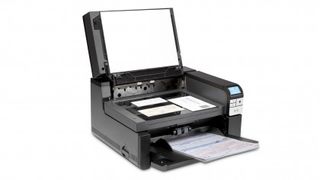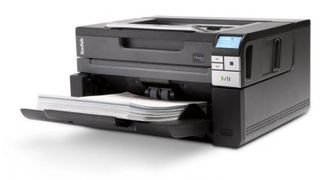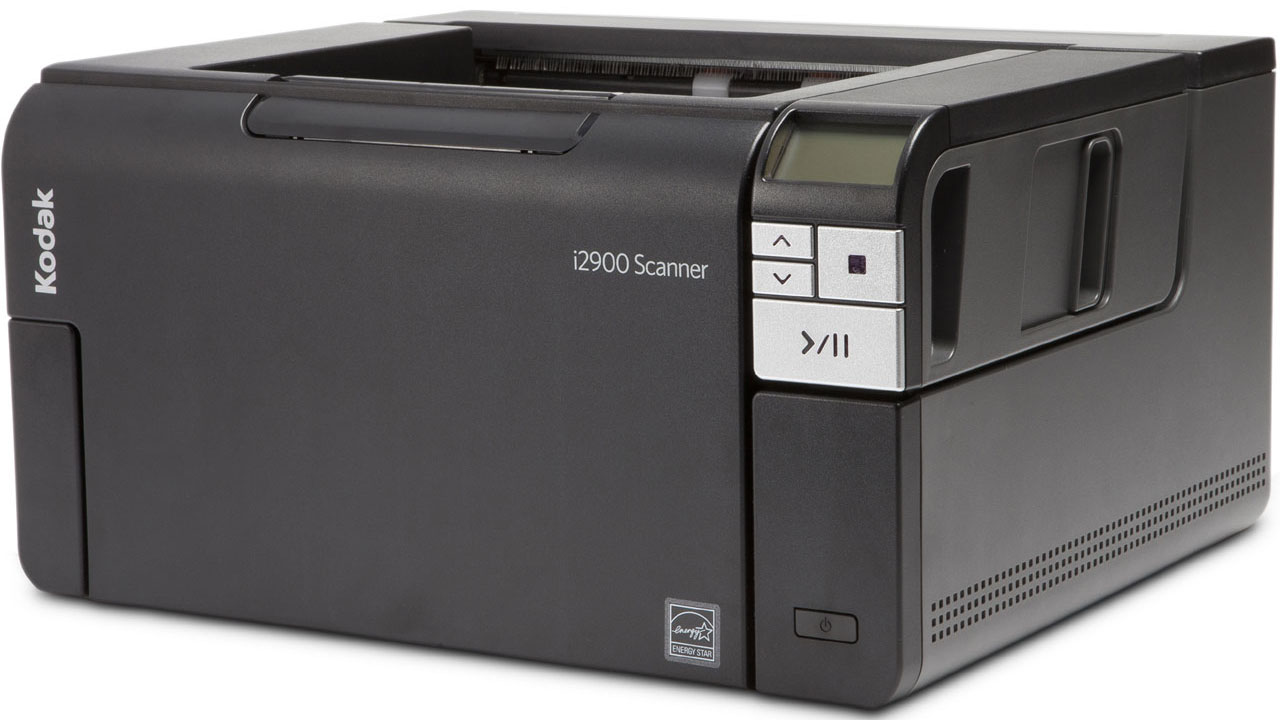TechRadar Verdict
Pros
- +
Very fast
- +
Good at scanning books
- +
Robust build quality
- +
A relatively small footprint
- +
Duplex scanning option
Cons
- -
Expensive
- -
Not Mac compatible
- -
Only nine presets possible
- -
A3 scanning costs extra
- -
Some options a little unclear
Why you can trust TechRadar
For decades we've been told the paperless office is just around the corner, and that soon, all documents, brochures and mailings will be handled electronically. Yet despite increased use of PDFs for large documents such as product manuals, email for much of what used to be sent by post and USB sticks or optical discs replacing the traditional brochure or press pack, the fully paperless office still eludes us. Things are still printed. And they're also still scanned.
Kodak's high-end i2900 Scanner is intended for business use, for the busy office where a lot of document scanning is done. It's far from cheap – at the time of writing, the best price on Amazon is £1,839 – but it packs in numerous unique and pro-level features that really help the high-needs user.

For those with lesser needs, there are plenty of cheaper scanners and multifunction devices to choose from. Kodak's own ScanMate i940 is a compact, portable sheet feed scanner that can be powered from a single USB port. Just the thing for scanning on the go, and you can get it for under £250. For film scanning, the Reflecta ProScan 7200 gives better results than most flatbed scanners, and is very competitively priced at around £300.
Fujitsu's ScanSnap S1500M is expensive at around £500, but it's a fast, reliable sheet-feed scanner. If you prefer a flatbed model, the Epson Perfection 4490 Photo is, as you would expect, very good for photos and is quite reasonably priced. Of course, if scanning is only an occasional requirement, you might be better off with a multifunction printer, combining printing, scanning and photocopying features.
The Canon PIXMA MX895 and the HP Officejet Pro 8500A are both excellent inkjet options, and if you prefer a laser printer, there's the Brother MFC-7440N or the Samsung SCX-4500 mono MFD.
But if you need a really powerful scanner that's robust enough for a busy office, the Kodak i2900 better suits your needs. It's incredibly powerful, and packed with features that prove a real boon for power users, and with a recommended daily volume of up to 10,000 pages for the sheet feed scanner and 100 pages for its flatbed scanning utility, it's certainly ideal for those with huge quantities to scan. But the scanner itself is far from huge. With a depth of 37.1cm (with input tray closed), a width of 43.2cm and a height of 23.8cm, it has a surprisingly small footprint.
Features
The Kodak i2900 is two scanners in one; there's a sheet feed scanner with an automatic document feeder that can hold up to 250 sheets, and a flatbed scanner for books, magazines and other such projects which you can't run through the scanner as single pages. The sheet feed scanner can handle pages of up to A4 in size. Out of the box the flatbed scanner is A4 too, but you can buy an optional Kodak A3 Size Flatbed Accessory to take it up to A3 size.
The sheet feed scanner is clearly built for speed. We're promised up to 60 pages per minute in colour or black-and-white at 200 or 300dpi, though exact speeds depend on the driver, application software and computer on which you're doing the scanning. The input ADF is at the front of the scanner. The tray on which the documents sit automatically rises to make sure the paper is fed into the scanner in exactly the right way. The output tray is on the top of the scanner, but if you're scanning a very long document or something printed on thick paper or card, which could prove problematic for a rotary scanner such as this, you can opt to use the rear-exit paper path. Naturally this takes up more room, as you need to keep the back of the scanner clear, but it's a useful feature all the same.

Another useful feature is the book-edge flatbed scanner, whereby the scannable area comes all the way to the front edge of the scanner. This means instead of placing a book or perfect-bound magazine flat on the glass and pressing down as hard as you dare, you can place the inside of the spine against the edge of the scanner, allowing the page you're not scanning – and indeed the rest of the book – to hang down without getting in the way. Watch Kodak's YouTube video [http://youtu.be/X_4IzAOTmsg] of the scanner in action and you'll see what we mean. The reason it's so welcome a feature is that when scanning books on a standard flatbed scanner, the image tends to 'curl' as the section where the pages meet (known in publishing as 'the drain') doesn't sit properly on the glass.
Using the scanner's Smart Touch control panel, you can streamline repetitive tasks, select output formats such as PDF or jpeg and more. Connectivity is through USB.

